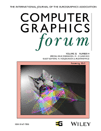Interactive Lighting Design with Hierarchical Light Representation
Abstract
Lighting design plays a crucial role in indoor lighting design, computer cinematograph and many other applications. Computer-assisted lighting design aims to find a lighting configuration that best approximates the illumination effect specified by designers. In this paper, we present an automatic approach for lighting design, in which discrete and continuous optimization of the lighting configuration, including the number, intensity, and position of lights, are achieved. Our lighting design algorithm consists of two major steps. The first step estimates an initial lighting configuration by light sampling and clustering. The initial light clusters are then recursively merged to form a light hierarchy. The second step optimizes the lighting configuration by alternatively selecting a light cut on the light hierarchy to determine the number of representative lights and optimizing the lighting parameters using the simplex method. To speed up the optimization computation, only illumination at scene vertices that are important to rendering are sampled and taken into account in the optimization. Using the proposed approach, we develop a lighting design system that can compute appropriate lighting configurations to generate the illumination effects iteratively painted and modified by a designer interactively.




